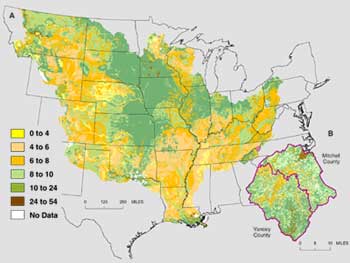USGS Contributions to the Climate Change Science Program
CARBON CYCLE
From studies of the geologic record, it is known that the distribution of carbon among major carbon sinks and reservoirs has changed with past changes in climate. Links between the global carbon cycle and the global climate system are complicated, involving atmospheric carbon dioxide (CO2) and the "greenhouse effect". Atmospheric CO2 concentrations are presently increasing as a result of human activities. This increase may affect the global climate. Therefore, it is important to understand the global budget of atmospheric CO2. USGS research is conducted in cooperation and partnership with other agencies and academic collaborators in direct support of the Carbon Cycle Science Program. USGS carbon cycle research includes the following activities:
Carbon sequestration in sediments - Redeposition of eroded soils and sediments and their associated organic carbon is sequestering large quantities of carbon, buried at the base of slopes and in wetlands, riparian areas, reservoirs, etc.
Landscape dynamics and vegetation change - Research examines the long-term dynamics of vegetation change and the impact of climate. A detailed history of vegetation change in the Western U.S. is being constructed based on the paleobotanical record of pollen and plant tissues preserved in packrat middens and buried in sediments.
Fate of Carbon in Alaskan Landscapes - Cold region forests (boreal ecosystems) contain large carbon reserves that are highly susceptible to changes in climate. Changes in fire and seasonal temperatures may cause changes in ecosystem structure, permafrost recovery, nutrient cycling, and carbon exchange. Central to the fate of these C reserves is the interaction between fire occurrence and permafrost changes in the surface layers. Process studies and modeling are being expanded to better understand the historic and modern interactions among climate, surface temperature and moisture, fire, and terrestrial carbon sequestration.
Exchanges of Greenhouse Gases, Water Vapor, and Heat at the Earth's Surface - Atmospheric turbulence transports greenhouse gases (notably: CO2, methane, and nitrous oxide), water vapor, and heat between Earth's land and water surfaces and the overlying atmosphere. These exchanges influence climate, viability of ecosystems, distribution of biomes, and the quantity of both surface- and ground-water.
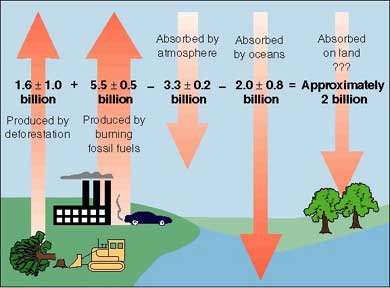
The global CO2 budget can be defined as the balance of CO2 transfers to and from the atmosphere. The transfers shown here represent the CO2 budget after removing the large natural transfers which are thought to have been nearly in balance before human influence. Units are in metric tonnes of carbon per year. Budget figures shown here are for the 1980's. |
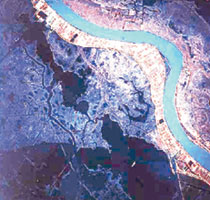
|
Aerial photo of the Mississippi Delta near Port Sulphur, Louisiana. Land-use and industrial activity may be influencing the carbon budget of the Earth and leading to large-scale climate change. The USGS is conducting a detailed study of the Mississippi River drainage in an attempt to understand and model the contributions of this region to the world's carbon budget. |
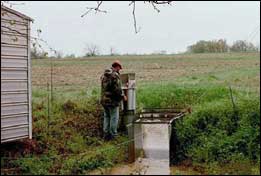
USGS carbon cycle researchers are working with USDA scientists to measure carbon exported from eroding agricultural fields in Mississippi (National Sedimentation Laboratory), Iowa (National Soil Tilth Laboratory), and Ohio (North Appalachian Experimental Watersheds). These measurements are part of a larger study evaluating the redistribution of soil organic carbon from eroding uplands to alluvial and reservoir sediments. The deposition and burial of organic-rich sediments constitutes one important mechanism for carbon sequestration.
Spatial distribution for soil organic carbon (SOC) using site-specific soil-pedon data linked to (A) STATSGO map units (1:250,000 scale) for the Mississippi Basin, USA; and (B) SSURGO map units (1:12,000 to 1:24,000 scale) for Mitchell and Yancey Counties, in the Southern Appalachians of North Carolina.
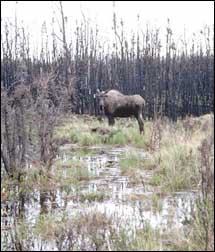
Cold region (boreal) forests contain large carbon reserves that are today highly susceptible to changes in climate. Soils and wetlands comprise over 2/3 of the boreal carbon reserves and have sequestered large amounts of carbon since retreat of large glacial ice masses. Changes in fire and seasonal temperatures have been shown to cause changes in shallow permafrost, nutrient cycling, ecosystem structure, and ultimately carbon exchange. Large fires in the boreal forest are a basic element to forest regrowth, species diversity, carbon storage, and carbon exchange. Although fire is a primary mechanism for direct carbon loss from the ecosystem, forest regrowth and peat accumulation are mechanisms for carbon uptake. Fire disturbance drastically changes the active layer and its biogeochemistry for several decades, and this change in turn impacts the water table and bordering wetlands. In some areas, perhaps where fires are most severe or perhaps where fires recur more quickly, permafrost degrades irreversibly.
U.S. Department of the Interior | U.S. Geological Survey
URL: http://geochange.er.usgs.gov/poster/carboncycle.html
Page Contact Information: ESD Web Team
Page Last Modified: Mon 16-Jun-2003 19:06:28 MDT
Accessibility, Privacy, and other policies and notices
